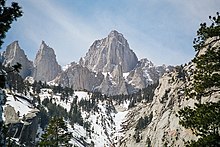|
Sierra Peaks Section
The Sierra Peaks Section (SPS) is a mountaineering society within the Angeles Chapter of the Sierra Club that serves to provide mountaineering activities for Sierra Club members in the Sierra Nevada, and to honor mountaineers who have summited Sierra Nevada peaks. HistoryThe Sierra Peaks Section was established in 1955. The Section maintains historic summit registers at Bancroft Library on the University of California, Berkeley campus.[1] MembershipTo become a member of the SPS, one must be a Sierra Club member and have climbed at least six peaks on the SPS List; it is not necessary that the peaks be Emblem peaks. For verification purposes, two of those ascents must be done on an official SPS trip.[2] Especially accomplished members are award with emblems, with the following grades (from highest to lowest):[3]
Upon receiving one of the normal emblems, members may be recognized with one of the following additional emblems, which are not ranked:
SPS ListTo the general public, they are most known for their peak bagging list, created in 1955, a product of the Sierra Club's long legacy of promoting climbing in the Sierra Nevada.[4] Completing the list is highly prestigious in American mountaineering circles, and climbers who complete the list are often cited as having done so (e.g. by the American Alpine Club).[5] The list is divided into three levels of importance. The Emblem peaks are considered the most iconic peaks of the Sierra Nevada, and to summit all of them is the goal of many peak baggers and alpinists. Mountaineers peaks are less notable peaks known for presenting mountaineering challenges; they do not have the prestige that Emblem peaks have attached to them, but ascending them is necessary to gain higher levels of recognition for Section members. Finally, there are the numerous general peaks of lesser note.[6] Some peaks require substantial rock climbing experience (e.g. North Palisade and Mount Clarence King), and in some cases snow travel skills. Most peaks may require few technical skills, although the commonly cited difficulty ratings of peak climbs in the Sierra Nevada are considered to be understated, or “sandbagged”.[7][8] The majority of peaks are very remote and require substantial cross-country travel. The list is an example of a subjective "decision by committee" list with the peaks on the list being determined by the Sierra Club. Peaks are occasionally added or removed from the list due to a variety of factors, such as accessibility, notability, and interest.[9] The list is followed by thousands of hikers and climbers and has been noted in numerous books and guides on the Sierra Nevada. There are 15 Emblem peaks, 35 Mountaineers peaks, and 197 general peaks, for a total of 247 peaks.[10] The number of peaks is traditionally set at 248, the original number of peaks listed in 1955; however the number changes at times due to issues such as legal access or higher interest in one peak over another. The elevations listed below are those officially described on the list (based on USGS topographic map contours), and may not be the actual elevations of those peaks, although they are usually accurate to within 50 feet. Emblem Peaks 
Mountaineers Peaks 
Full listArea 1: Southern Sierra
Area 2: Mineral King and Kern River
Area 3: Olancha to Langley and west
Area 4: Corcoran to Whitney
Area 5: Whitney to Williamson
Area 6: Kaweahs and west
Area 7: Great Western Divide
Area 8: Kings–Kern divide
Area 9: Kearsarge Pass vicinity
Area 10: Baxter Pass to Taboose Pass
Area 11: Western mid-Sierra
Area 12: South Palisades
Area 13: Mt. Goddard vicinity
Area 14: North Palisades
Area 15: Evolution area
Area 16: Humphreys Basin and west
Area 17: Bear Creek Spire area
Area 18: Mono Creek to Mammoth
Area 19: Ritter Range and vicinity
Area 20: Clark Range and vicinityArea 21: Mt. Lyell and north
Area 22: Tioga Pass to Bond Pass
Area 23: Bond Pass to Lake Tahoe
Area 24: Northern SierraSee alsoOther peak bagging lists: References
Bibliography
External links |
